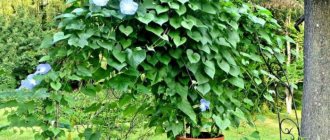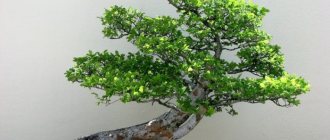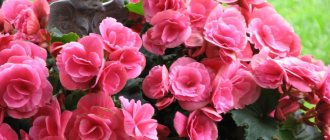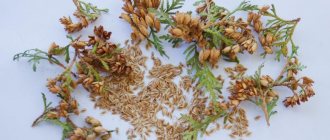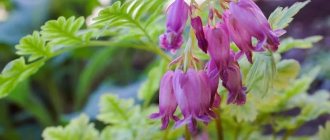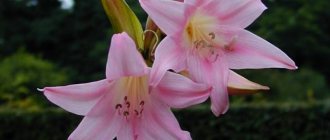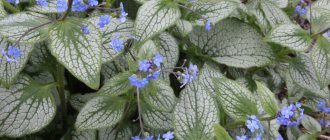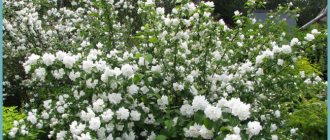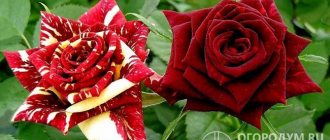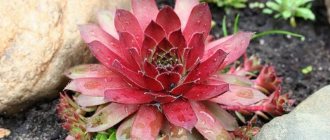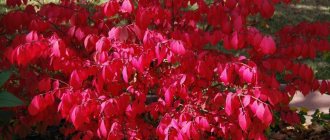The uniqueness of using hosta in an outdoor interior lies in its sociability. The plant can fit into almost any design; the classic shape and species diversity only contribute to this.
Among the varieties of hostas there are dwarfs and giants, plants with green, yellow and even bluish foliage
The universal properties of the bush are:
- Variable combination.
- Unpretentiousness.
- Easy rooting, propagation.
- Rich appearance.
- Long lasting decorative effect.
What is the best thing to combine hosta with when planting?
Many plants can be planted next to hostas, but there is a nuance (besides the obvious - the coincidence of requirements for living conditions). Don’t forget to immediately check what size the host will reach when it grows up - the leaf span of an adult plant can be very, very significant. Here's an example of one of my own long-standing missteps:
Everything is fine, but the primrose is planted too close to the host. At that time, I didn’t take into account that as the hosta grew, it would cover all the free space between two astilbes (by the way, they are wonderful neighbors). The primrose had to be replanted. Therefore, relatively small plants such as lungworts, primroses, daisies and others should be planted at some distance. In the summer it all looked like this (the hosta is still young - with age it has become much larger):
But small-bulbous plants (muscari, chionodoxa, pushkinia, scillas, crocuses and others), as well as daffodils (that is, everything that does not require annual digging - tulips will not work) can be planted closely: when they bloom, the hosts are not yet visible , and by summer its powerful leaves will cover the unsightly “bald spots” in place of the withered foliage of the bulbous plants. And here is an option where late muscari grow next to compact “blue” hostas:
White sedum spreads under them (both it and various forms of false sedum are excellent neighbors for hostas)
In the background is Byzantine chist, which also sits well next to the hostas. For example, like this:
Hostas and cypress spurge look good next to each other (just be careful that it doesn’t grow too much)
Here are the hostas in the shade of the ferns; on the side - variegated sedge (in any case, that’s what the neighbor who shared it with me called this plant), perhaps experts will clarify the name):
Combinations of hosta with ground cover plants are very successful (both wild ones, such as ivy bud, and cultivated plants, such as sedums, periwinkles, and others, are also suitable). In general, even the entire seven-dacha community probably won’t be able to compile a complete list of everything that can be planted next to hostas))) There are a lot of options!
Exactly, there are many combinations with hosta. The main thing is that there is a contrast then it’s beautiful. That is, the leaves of the hosta are oval or rounded and whole, which means we plant a leaf with the opposite shape next to it (cut-leaved or openwork). The main thing is not to forget that the leaves of the hosta are very dense and good rain is needed for the water to reach the roots of the hosta. Especially the blue giants.
Here in the photo of the host is a blue giant, and next to it is a kitten. You can see for yourself that nothing grows nearby. And this hosta is still a baby, she is 2 years old. It will increase a little more.
Ferns grew next to the hosta, but I had to move them and will move them again.
And here’s what I wrote about: the contrast of leaf shape and color
In general, the hosta is considered a universal “garden decorator”. Purely in form, most plants are compatible with it. Only, of course, not those who prefer open sun. That is, they will look good next to each other, but the host herself will suffer. And also - depending on the size of the hosta. There are very large hostas, with huge leaves, next to them only tall lilies, delphiniums, phlox, daylilies, onions, ferns, rhododendrons and similar plants will look good and will not suffer from it. The main thing is that the hosta companions are not undersized - otherwise it will cover them over time, even if the variety is relatively small. Sometimes, in any case, you have to tear off some of the leaves of the hosta from time to time so that it does not step on neighboring plants. By the way, you can staple a very beautiful tablecloth from torn hosta leaves - for one day, of course, but suddenly you are expecting guests, and this will be an original accessory.
Option with early flowering plants
While the hosta is just emerging from the ground and begins to unfurl its leaves, the flower garden can be decorated with bulbous and other perennial early flowering plants: tulips, hyacinths, daffodils, crocuses, primroses, snowdrops, lilies of the valley, scillas, and corydalis. These spring flowers are the very first to please the eye, so they are perceived especially brightly. It is also worth knowing that all varieties of primroses are absolutely unpretentious to care for, as they are endowed with high immunity. Thanks to him, they can easily tolerate a significant decrease in temperature.
By early summer, many of these early plants will be gone, and the large leaves of the hosta will quickly cover the fading primroses. Thus, the flowerbed in which primroses and hostas grow will always look elegant and attractive.
Hosta. (Photo used under standard license ©ogorodnye-shpargalki.ru)
Hostas in the garden - landscape tricks
A well-groomed garden and the facade in front of the house is the dream of many gardeners. To implement it, you need to start with landscape work. Hostas are considered the most popular used for decorating not only garden plots, but also park areas. These decorative herbaceous perennial plants are so popular and irreplaceable that it is impossible to imagine a single nook of the garden without them.
Hosta was previously called funkia; its main places of growth were China, Korea, and the Far East. The variety of herbaceous perennial includes more than 60 species of hosta, it is known in all corners of the globe. Why is it attractive? The leaves and their color are the main decoration of the hosta. In the garden, the landscape tricks of the designers are manifested in its harmonious juxtaposition with many beautifully flowering plants and tall cereals.
There are many varieties of hosta. Even classic perennial bushes with green leaves are not the same. The drawings on them have dark and light colors. Borders, stripes, white streaks in various variations create unique combinations on the leaves, changing the appearance of the plant.
Ready-made schemes for juniper flower beds with other flowers and plants
Chaotic placement of juniper bushes on a site does not give such a visible aesthetic effect as planting according to a special scheme. With different types of flowers, plants and other conifers, juniper bushes create unusual but very beautiful combinations. That is why planting according to special schemes is very popular among gardeners. Juniper looks most advantageous with such “neighbors” as barberry, hydrangea, spirea, thuja, hosta, as well as with various flowers and compositions in flower beds.
How to plant hostas beautifully
The most unpretentious of the plants that are planted on a personal plot or in a garden is considered to be the hosta. It grows even in the most shaded areas. Many of its varieties thrive both in sunlit areas and in corners of the garden with diffused but bright light.
Variety of hosta species
Flower growers recommend determining the best place to place the hosta by planting it in different parts of the garden. Next year it will become clear in which of the selected areas the plant feels better. This can be determined by the color of the foliage. Next, you can transplant the grown bush to the chosen location. The perennial is unpretentious in care and tolerates changes in habitat painlessly. If necessary, hosta can be grown in a container for the purpose of landscaping balconies and terraces.
Advice. It is better to grow a perennial plant by dividing the rhizomes. Experienced florists believe that this method is more convenient than growing hostas from seeds.
Planting this herbaceous plant in carpet design looks beautiful. Its large leaves prevent weeds from growing in the garden. Carpeting in this case is considered not only decorative, but also useful.
Neighborhood with conifers and juniper
Contrasting combinations involving hosta
The desire to create a bright and eye-catching flower garden unites all gardeners. But in order to do this with the participation of hosts, it is necessary to take into account a number of very important nuances and features of this process.
- If the hosta bush is quite lush and its leaves have a uniform color, this hosta is best used as a background - that is, as a green background for other flowering or non-flowering plants. As a background, the hosta goes well with, for example, peonies. Ferns, dicentras or astilbes can easily become her partners in this matter.
- As a rule, those varieties of hostas whose foliage is painted in two or more shades or colors, as well as hostas whose varieties are classified as large, are considered decorative. When combining the latter with coniferous plants, you can get a result of amazing beauty and prolonged action.
- To create a contrasting landscape element with the help of a hosta, she should take as assistants representatives of the flora, which are similar in shape to the bush, but at the same time have a radically different color of foliage. For example, Horny Goat weed, the leaves of which are burgundy. Or heuchera, which is the lucky owner of purple leaves.
To add vertical accents to your floral arrangement, use plants that are taller than hostas. For example, phlox, which blooms profusely, or kupena. Daylilies are also ready to complete the created composition. The final touch to such a planting can be some representatives of cereal perennials. For example, miscanthus.
What to plant next to hostas
What does hosta go with in a flowerbed? These ornamental plants get along well with all flowers, so the question of what to plant next to the hosta does not arise. Previously, this perennial plant could rarely be found in flower beds and flower beds. It was considered something special among the usual plants and flowers. Modern varieties decorate flower beds and paths. They look wonderful surrounded by roses, peonies, hydrangeas, and irises. A good tandem of hostas in a flower bed with geraniums. These plants are a decoration for any flower garden: from a ceremonial composition to a shady corner in a landscape style.
Juniper and barberry
This combination may also contain other shrubs and plants, for example, thujas or pine trees. When choosing varieties, people most often pay attention to Thunberg barberry, rocky (Skyrocket) and medium juniper (Mint Julep). The number of elements in a flower bed is usually 5, 6 or 7. Larger plant compositions are used when designing large areas. Recommended flowering plants are rhododendrons, hydrangeas, primroses.
Designers recommend giving preference to dwarf barberries, for example, Arthropurpurea Nana, Harlequin, Kobold, Minor, Aurea. They have a denser crown and are characterized by slow growth.
Hosta in landscape design
Designers use a variety of hosta varieties in their compositions. They are attractive because they tolerate low temperatures well, are frost-resistant, which means they are a perennial decoration. These perennials are divided into varieties with original glossy, waxy and matte leaf coating. There are varieties with very large leaves, and these ornamental plants also have small leaves. The type of leaf is also varied. Its structure can be smooth, embossed, wrinkled and with wavy leaves.
Interesting. There are miniature varieties of perennials, the height of which is just over 10-15 cm. They appeared in the last decade and have taken root in home floriculture. Subspecies of hosta varieties are used in garden landscapes.
It all depends on the height of the herbaceous perennials. Ground cover - have a height of up to 20 cm, border - from 20 to 30 cm, medium-height - 30-45 cm and high - from 45 to 80 cm. With their help, you can, using optical illusion, revive the darkest corners of the garden, creating multi-tiered compositions.
Hosta in the flower garden
Thanks to the beauty of their leaves, herbaceous bushes are not only a decoration for gardens. The leaves are used to create original bouquets. This large-leaved plant looks beautiful both growing alone and in monogroups, creating complex compositions from different varieties. Landscape designers use hosts:
- when creating flower beds;
- as a border plant, decorating the front edge of the composition;
- in freely growing groups;
- in rockeries;
- like tapeworm or large spots on the lawn;
- in the design of regular mixborders and flower beds;
- in rock gardens and Japanese-style gardens;
- in creating small decorative ponds,
- in dividing the flower bed into sectors;
- in the form of carpeting or a green “pillow”.
Hosts at their summer cottage
Classification
Today there are more than 600 varieties. Based on their characteristics and features, several options for categorization into groups are used.
By type:
- glossy;
- matte;
- motley;
- with a white or green border around the edge.
According to the range of green mass:
- turning green;
- yellowing;
- whitening.
By form:
- long;
- round;
- lanceolate;
- heart-shaped;
- narrow;
- wide.
According to the height of the bush (excluding peduncle):
- miniature (dwarf) – up to 10 cm;
- small (ground cover) – 20 cm;
- medium (border) – 30 cm;
- large – 45 cm;
- giant - over 60 cm.
There is no single international standard for the parameters of each category, therefore, in different countries there are often differences between the classification of species into one group or another.
Flower garden or flower bed with hostas
The herbaceous shrub will not get lost in a bright flower garden. The plant creates interesting compositions in the colorful flower beds, the originality of which receives its share of admiration. Flower beds fenced with borders of greenery look more attractive, especially when hosta is involved in the design of flower borders. With the help of designers, you can choose the right varieties with different sheet colors and their location in the border. This will be the key to the beauty and uniqueness of the flower garden.
Hosta border
Border plants are involved in creating a landscape near a house on a personal plot. They separate decorative and functional areas. Hosta is considered a wonderful plant, often used to create a green border. Designers suggest making compositions of at least three of its types with different height levels, planting along the paths. The main thing is the compatibility of the selected varieties of this perennial plant in shape and color, thereby creating a unique pattern. Border varieties include miniature Blue Cadet plants with blue leaves or Light Up.
When creating a beautiful and durable garden design, you should listen to the advice of landscape designers regarding the choice of planting site, lighting, and proximity of plants.
LiveInternetLiveInternet
—Categories
- For children (61)
- Training (32)
- games (14)
- Educational toys (9)
- Crafts (4)
- Poems (2)
- Topiary (18)
- Sales organization (13)
- Aphorisms, quotes, proverbs, wise thoughts (3)
- Knitting (2)
- Crochet sweaters (2)
- Wedding accessories (1)
- Video (3)
- Vintage (1)
- Decor (13)
- master classes on decor (11)
- Decoupage (541)
- Inspirello (18)
- Marina Trublina (17)
- Alisa Luchinskaya (47)
- Anna Turchina (24)
- Ascetic (60)
- Bottles (5)
- vases (5)
- Video lessons (42)
- Evgenia Bazhenova (4)
- Elena Perestoronina (45)
- Imitation of various materials (36)
- Craquelure (36)
- kitchen (5)
- Marina Nikulina (15)
- Natalia Rodina (27)
- Natasha Fokhtina (34)
- Christmas balls (66)
- new year (6)
- Polish decoupage (4)
- Watches (3)
- Shabby chic (12)
- Decoupage. For inspiration (122)
- Key holders (1)
- Dressers (6)
- Watering cans (1)
- Miscellaneous (23)
- Decoupage. Materials (56)
- Decoupage. MK (157)
- Bottles (10)
- For the cottage (124)
- Home interior (9)
- gazebos (9)
- flower pots and flowerpots (5)
- Landscape design (55)
- Crafts and garden decorations (35)
- paving slabs and covering (10)
- For the kitchen (4)
- Interior (2)
- Gift ideas (15)
- from coffee (1)
- Interesting sites (9)
- interior (14)
- Pictures for decoupage miscellaneous (336)
- Africa (7)
- Curbs (6)
- Vintage (17)
- Kitchen (25)
- Bears (6)
- Men's (11)
- New Year's (67)
- Birds (3)
- Miscellaneous (82)
- Serial (14)
- Backgrounds (23)
- Floral (71)
- Cardboard boxes (64)
- mk cardboard boxes (54)
- MK matchboxes (2)
- new year (1)
- Training (5)
- English (2)
- Computer (3)
- Newspaper weaving (5)
- Repair (2)
- Scrap kits (953)
- Colors (143)
- Spring (61)
- Tender (43)
- Handicrafts (6)
- Travel (4)
- Vintage (136)
- Children's (217)
- Winter (118)
- Summer (51)
- Marine (40)
- Male (17)
- Autumn (62)
- Wedding (65)
- Scrapbooking (481)
- Albums, books (158)
- Clipart (49)
- Master class (107)
- Men's (28)
- Lettering (48)
- Cards for inspiration (35)
- passbook (12)
- Sketches (24)
- Links (15)
- Scrapbooking.Pictures for printing (194)
- Housekeeping tips (2)
- Bags (8)
- Jeans (2)
- Organizer, storage (4)
- bottle packaging (3)
- gift wrapping (15)
- bows (8)
- lesson on LiRu (38)
- Photos (68)
- photo processing (1)
- programs (13)
- Photography Lessons (26)
- photoshop (27)
- Flowers (30)
- paper flowers (20)
- braid flowers (11)
- Caskets (59)
- MK (39)
—Tags
—Search by diary
—Subscription by e-mail
-Statistics
Compositions with hostas in the garden: 15 examples with photos
Hosta is a spectacular “decorator” of gardens. Whatever type of hosta you choose - low-growing, large, plain, blue, with veins - it goes well with any plants and flowers. Hosta transforms flower beds with ferns and cereals, adds zest to mixed borders with conifers, frames paths and flower beds with tulips, astilbes and irises. In this article I will tell you how best to plant hosta and give examples of the best compositional combinations of hostas in site design.
Features of planting hosta
Hosta is perfect for planting near a pond, in the shade, as a soloist or in a group with other plants. It is better to plant hostas in fertile, moist soils. The plant is winter-hardy and disease resistant. It grows quietly in one place for 10-15 years without losing its decorative effect. Easily propagated by seeds and dividing the bush.
Ideal place to plant hosta
Experienced gardeners do the following: they plant several bushes in various areas of the site, and observe how they feel, their growth rate, color change and flowering. And where the host produces the best results is the “ideal” place.
- Hosta grows well in both shade and partial shade.
- Many species thrive in bright sun.
- Blue hostas should only be planted in a shady corner.
- In hostas with white veins, bright sun causes burns.
IMPORTANT
The same hosta variety planted in the shade and in the sun will have a different color.
Ideal for hosta are places with moist soil (near bodies of water, in the forest area of the garden).
Tips for planting hostas
1. It is better to plant hosta in the spring, but it also takes root well in the summer.
2. For planting, you need to prepare a landing hole:
- The hole should match the size of your seedling. Make sure that there is room for the roots, and do it with a reserve, because the hosta grows quite quickly.
- We fill it with compost and peat mixed with garden soil taken out of the ground. If the soil is clayey, then it is better to lay a drainage layer at the bottom of the hole.
3. Before planting, remove all weeds and dig up the soil onto the bayonet of a shovel.
4. We spill the planting hole with water and place the seedling without deepening the root collar and straightening the roots to the sides. If the seedling is from a purchased container, then we place it together with a lump of earth so that the base of the plant remains in the same place where it was in the pot (do not bury it).
5. Then we press the soil a little with our palms and water again. If the ground sags a little, then fill it up and level the surface.
Photo: hosta in garden design
Caring for hostas after planting
After planting, it is better to mulch the surface - this will make the plant more comfortable, and you will have less hassle with frequent watering and weeding.
- Sometimes the ground around the hosta is mulched with agrofibre. But this is closer to professional landscape design.
- Amateur gardeners can use mulch, such as sawdust or pine chips. They will protect the plant from pests such as slugs, which love damp and cool places.
If the soil dries out quickly, the hostas will need to be watered deeply and frequently. They love to drink!
Photo: mulching hosta with agrofibre
Compositions with hosts: examples and photos
Below are examples of compositional combinations of hostas with other plants and flowers.
Kinds
About 40 species are known, each of them is characterized by high decorativeness and ease of care. There are both shade-tolerant and those that grow in sunny areas. Below, in alphabetical order, is a description of the most popular of them.
White-edged
It got its name due to the presence of a white border; the center is painted in a rich green tone. Medium height, up to 70 cm in diameter. One of the most hardy and unpretentious.
Related article:
Fragrant carpet: Five best perennial ground covers for flower beds and gardens
Bloated
Large heart-shaped leaves with a dark green matte leaf are noted. The root system is located superficially. The flowers are lilac or violet.
Wavy
Originally from Japan, one of the most common in the regions of the Russian Federation. The leaves are smaller than those of other representatives of the genus, pointed. They are distinguished by a white stripe in the middle. Height reaches 30 cm.
Siebold
One of the most beautiful, distinguished by large gray-green plates (size 40*25 cm) in the shape of an oval with a point and a coating. The flowers are lilac in color, arranged in a brush.
Curly
Neat bushes with a white edge, slightly wavy around the perimeter. The flowers are purple, located on tall stems.
Lanceolate (narrow)
Characterized by lush large plates (up to 15-17 cm in length) on high petioles. The rosette is basal, wide. Funnel-shaped flowers are collected in a brush and placed on long (up to 50 cm) smooth stems-peduncles. Flowering occurs in July.
Small
Miniature dwarf, up to 15 cm tall. Leaves are elongated and neat. The flowers are purple.
Podorozhnovaya
One of the most interesting and beautifully flowering species. Massive, with distinctive characteristic “ribs” throughout the plate. Large lily flowers bloom on tall peduncles (up to 70 cm). There is a subtle pleasant aroma and long flowering until August-September.
The smell and sweet juice on the flower stalks can attract ants and black aphids.
Erectifolia
Distribution area: Far East. Characteristic are small, erect, upward-pointing bushes.
Fortune
Compact, dense, heart-shaped, light purple flowers. It goes well with others, shading off brighter or more variegated ones.
Related article:
7 photo ideas on how to organically integrate beds into the design of the site
Fortune Patriot
Ovoid
It grows up to 40 cm in height. Clusters of small flowers bloom in July-August.
Hostas in the garden (landscape tricks)
Nature has created an innumerable number of different plants. Moreover, in the natural environment there is no dissonance in the combination of different neighboring cultures. With a good imagination, you can take a lot from the wild to create a paradise on your property. For example, hostas in the garden and landscape tricks for growing flowers are of great interest in the design of a flower plot. The use of hosta in garden landscape design when decorating flower beds has many options. The abundance of varieties and types of this crop (about 50 species and more than 700 varieties) will help you create absolutely charming compositions.
Spectacular astilbe
Astilbe is one of the best hosta partners. With her participation, you can create many different flower bed design options. Together they will decorate borders, shady places under tree crowns, artificial ponds and fountains, and alpine slides. In addition, these crops are similar in terms of care principles, as they prefer to grow in shady and humid places. They are resistant to severe frosts and do not need shelter.
Astilbe is a picky perennial that delights with its lush flowering for a long time (from June to September). The flowers exude a delicate aroma that is similar to bird cherry. Even after complete flowering, astilbe looks very good.
The variety of varieties, differing in height, color of openwork leaves, which are bronze, burgundy, dark green, and inflorescences (snow-white, bright red, purple) allows you to create unique compositions and combinations with lush hosta rosettes.
Astilbe. (Photo used under standard license ©ogorodnye-shpargalki.ru)
Basic rules of landscape design
Without going into the complexity of the design, you can note some quite understandable rules for yourself. They consist of:
- Unity of style. This means that both the buildings on the site and the flower beds must be in the same style. If you want to grow a garden in some kind of national setting, then the entire landscape will have to be adapted to this type, that is, buildings and fences will have to be camouflaged, and harmonious plants will have to be chosen.
- Simplicity of design. This is not a matter of boringness, but of the dosage of details of the future garden. A small area loaded with unnecessary decoration causes anxiety and a feeling of lack of taste in the creator of the composition.
- Dominance and submission. One prominent plant is selected as the basis of the future flower garden, and all the others are selected to match it. The goal is to obtain a single composition, where each plant is designed to highlight the beauty of the main element.
Therefore, even before creating a garden, it is worth choosing the right plants and decorative details that match them (figurines, borders, tiles for paths, lanterns, fountains).
Important! You can choose any component of the composition as the main element, including decorative elements.
Geometry in creating a flower garden
The design solutions are complemented by the use of geometric shapes when planning a flower garden. Depending on the task at hand, the size and shape of the site, and its location, the following are used:
- Triangle rule. In simple terms, this means that tall plants, for example, trees, are planted first, then lower bushes and then flowers. The shades of foliage from high to low also change from dense green to light green, light green and yellow. Moreover, each group is planted in a triangular shape.
- Rule of the circle. The circle helps distribute the color and light spectrum in the area. It can be divided into 2 or more parts and plants with related shades of flowers (leaves) can be planted in each of them. Just follow the rule of 3 colors, 3 sizes and 3 shapes.
- Rule of the square. It is based on the cardinal directions and involves planting plants according to size and content characteristics.
Schemes of flower beds with coniferous plants
Many gardeners try to create a beautiful flower bed in their own dacha without resorting to the services of landscape designers. Of course, this not only saves money, but also has a beneficial effect on our self-esteem, and also satisfies the creative impulse of “country designers.” If you don’t have enough ideas for inspiration, I offer a selection of flower bed planting schemes using coniferous plants to help.
How to beautifully plant hostas at your summer cottage or in the garden
To use a plant in the landscape, before breeding, you need to choose a permanent place for it and decide what to plant next to the hosta. It is not advisable to replant the crop. It is recommended to renew plantings after 6-10 years.
For your information! Hosta is capable of forming a dense green cover at the planting site in 2 years.
The place should be shady, calm with slightly acidic, moist soil. For lush growth, you should immediately pinch the emerging peduncle. The beauty of the hosta is in the leaves, and the flowers are rather inconspicuous, so you can do without flowering.
Handsome host at the dacha
It is important to keep in mind when planting that every year the plant will become more luxuriant, which means it will need good space around it.
Choosing a site for planting
You can grow hostas in the garden either in the center of the plot or in the background. Just take into account what plants the hosts are combined with. Based on the shade of the leaves, neighboring flowers are selected. For example, blue will look stylish with white, yellow with red, and other shades with green.
Important! If you have any doubts about choosing a place, you can try planting them in different areas and observe where they grow best. This place can be chosen as a permanent one for the next season.
With the arrival of autumn, the leaves of the plant are not cut off. The bush under the snow will serve as a shelter for the root system. Clearing of leaves is carried out in the spring.
Compositions from hostas and other plants
When creating compositions, it is important to take into account not only the design of the future flower bed, but also the matching growing conditions (abundance of moisture and shelter from direct sunlight)
Flowerbeds with heucheras and hostas
The composition of hosta with heuchera is one of the most successful options of its kind. This is explained by the fact that heuchera has flowers of delicate light shades (from white to red). They stand out well thanks to the juicy, dense greenery of the funkia. When creating a composition of these crops, it is important to take into account that heuchera grows up to half a meter in height, so it can be planted in various combinations with low-growing hosta. If the choice fell on large and tall hostas (from 80 cm to a meter), then they should always be planted in the background so that the heuchera does not get lost in their bushes.
Hostas in combination with astilbes
Astilbe and hosta share a love for shade, which is why they are often used together when creating compositions. The options for their use are limited only by the gardener’s imagination. Here are just a few of them:
- Create a beautiful garden frame using alternating hostas and astilbes.
- Arranging a flower arrangement to create a border along garden paths or ponds.
- An excellent option is a circular composition around a shady garden tree, which will fill the empty space underneath it.
- Finally, such compositions are often used to frame a lawn with even greenery in bright shades.
Other flower arrangements
Hosta fits into flower beds and other types of compositions with many plants, since varieties have different stem heights.
Basically, design moves are based on 2 ideas:
- Contrasting bright colors against the background of dark green hostas - gladioli, lilies, irises, delphiniums. The plant also contrasts well against the background of soft green foliage (small lawn vegetation, ferns).
- Creating multi-tiered compositions with height differences due to hostas and other plants. For example, the same gladioli can be placed in the background, and small varieties of hosta can be grown right in front of them. This will create the effect of upward movement due to the tiering and shape of the gladioli flowers.
Functionia can be used in a variety of ways, since there are many types of plants, and each of them has its own characteristics. At the same time, caring for the plant will not be difficult, so hosta is the choice of many gardeners, both among amateurs and professionals.
Hosta on an alpine hill
The basic varieties of the crop are quite large. They are not very suitable for alpine slides. But through the efforts of breeders, dwarf plant species have been bred. In addition, some of their properties have been improved. For example, resistance to sunburn, decorativeness of flowers.
New host hybrids
About 20 such hybrids have been obtained. The most spectacular of them are:
- Venus is a plant with small, shiny, heart-shaped leaves;
- Shining Tot features beautiful pale lilac flowers;
- Variegata - comes from Japan, has beige leaves with light green and green borders;
- longissima Maekawa has narrow emerald leaves with a frilly edge;
- Ground Master has narrow and long leaves, which are framed by a yellow stripe, and a very dense root system. It can be planted to strengthen the soil on the shore of a reservoir;
- Kabitan A distinctive feature of the species is lanceolate, folded leaves with a light green center and a dense green stripe along the edge.
Hosta green plantain Venus
The hosts Lemon Lime, Vanilla Cream and Geisha also look amazing. They are all yellow shades.
Dwarf hostas
Of the dwarf blues, the following are in great demand:
If it is impossible to acquire dwarf forms, it is quite possible to get by with basic varieties. On an alpine hill in the sun, their leaves will be smaller than in the shade.
Important! Hybrid varieties grow more slowly than basic varieties.
Still, in rock gardens, hosts are recommended to be placed in the shade of stones or other plants. In any case, they should not be planted at the top; it is worth choosing a place at the foot of the hill. It’s even better if the flower garden approaches the pond.
Compositions of juniper with thuja
In combination with thujas, other plants, for example, Grandiflora hydrangea, can be planted near juniper bushes. Approximate layout: the Cossack variety (Danub) is planted in the center, and western thujas (Vudvari) are planted on the sides; in the background it is permissible to place cone-shaped thujas of the Smaragd subspecies with needles that are brighter than those of Vudvari.
Recommended flowering plants: petunias, jasmine, daisies.
Why does hosta change leaf color?
The change in leaf color in many hosta species is genetic. Under any conditions, they will change color during the growing season. Shades can vary from white to blue. But their change can also occur due to climatic conditions or violation of maintenance rules. Changing species can be divided into:
- viridescent is when any initial spring foliage color changes to deep green by the end of the season;
- lucent - these leaves change color from the original light yellow (yellow, variegated) to dark yellow;
- albescent - hosta leaves change from yellow, light green and green in spring to white in autumn;
- fluorescent - the change in shades goes from blue to green, and the transformation occurs already in the middle of the season.
Flower garden with hostas
Once you use hostas in your garden design, you can admire the lush, beautiful bushes for many years. They will decorate flower beds even when other flowers have not bloomed. Moreover, their care is minimal.
Flowerbed with hostas and perennial flowers
Traditionally, hostas are planted with perennials such as:
Closer to the pond, the following are added to the flowerbed:
Distribution of plants depending on height
Dwarf hosta varieties are planted around evergreen coniferous bushes, and a tall variety looks beautiful alone against the backdrop of a tall tree, near ponds, in the last row of mixborders.
Important! In a rocky garden (rock garden), it is customary to combine dwarf conifers with yellow-leaved hostas.
Hostas of medium height look advantageous on the first row of borders.
Half-meter species harmonize with gladioli, lilies, delphiniums and irises of suitable height.
Garden compositions with contrastingly colored hostas
If you have a sufficient number of different varieties of plants, a large area, or a pond, it is appropriate to arrange a flowerbed of only hostas. For such purposes, contrasting types of different heights are often used, with the addition of a large plain version in the center.
Light yellow hosta looks gorgeous under a blue spruce
Contrasting will give a unique landscape to the flowerbed. A plot designed using this method looks expensive and unusual. You should use suitable tones, taking into account the dimensions, complementing the flowerbed with other plants of a similar theme. Until the hosta grows, you can dilute the space with annuals, add wood chips, and make a mosaic using stones. The host will reach its maximum size approximately in the second year after planting.
The variegated hosta will also feel good in a sunny flower bed if it is planted in the shade of taller perennials.
This composition will create the feeling of a cascade. Therefore, to ensure an even transition between bushes, designers first remove flower stalks. You can verify the correctness of the forms by looking at flower beds with photo hosts on the Internet.
Experts distinguish green, white and yellow hostas.
Unlike a single-color specimen, contrasting plants (green, light green and white) have thinner leaves and shorter height. Because of these characteristics, bright species are most common in flower beds, alpine slides, and in less shaded places. Splendor is created by plants located next to conifers. Figured cutting of bushes framed by contrasting hostas is a classic of the palace genre.
A small flowerbed in the middle of the lawn with Cossack juniper and hostas
Dwarf varieties of bright colors perfectly complement attractive small carpet-type flowers. Cute leaves with a white border can become an independent composition if planted in a strict shape (square, rectangle).
If you plant small hostas more often, in a few years they will make an excellent garden rug
Many variations are applicable today using host:
- maintenance of pedestrian paths;
- planting at the porch of the house, decorating facades, front entrance;
- combination of contrasting types with monochromatic ones;
- location at the foot of coniferous trees;
- decoration of roses
When planting contrasting representatives of the hosta, it is necessary to remember that the plants get burned from direct sunlight through drops of water. Therefore, it is better to water the bushes at the root, or late in the evening, otherwise the hosta will lose all its attractiveness. Otherwise, gorgeous greenery with white rays, or emerald green, will responsibly decorate the garden all summer, and in any weather.
The moisture-loving hosta is often used to decorate ponds.
What is permissible to plant next to hosta?
For example, hosta is shade-loving, which means it would be better to plant shade-loving plants nearby. Here are some of them:
Roses and conifers in landscape design
The last 2 crops will look great with tall varieties of hosta, but low-growing varieties are best combined with forget-me-nots, lungwort or mantle.
Note! The hosta feels comfortable in the shade of a thuja or garden cypress.
You can also create compositions exclusively from hosts. Due to the variety of leaf colors, different types and varieties will help you create an original design. In this case, there is no need to plant anything else next to the hosta.
Geranium, fern, mountain weed, peonies, heuchera, and all types of conifers are suitable as neighbors for the culture.
Hosta and roses
Being the queen among flowers, the rose does not really need neighbors. In addition, she loves open sunny areas. But some crops are quite capable of emphasizing beauty, helping to retain moisture in the soil and preventing attacks by harmful insects. One such plant is the hosta. True, they should not be planted in close proximity to rose bushes. They are, after all, different in terms of conditions of detention. Hosta can draw moisture onto itself. As a companion plant, hosta can be planted no closer than 30-35 cm from the rose bush. It is best to plant roses with one type of crop.
Flower garden with hostas and astilbes
There is good compatibility between hosta and astilbe in garden plantings. The main decoration is its leaves, which are:
In addition, the leaves are different in shape. There are round, narrow, heart-shaped. They also differ in size.
Not only are they different in color, but they also remain decorative until the frosts. Well, astilbe has a wonderful feature of blooming all season long, delighting with its colorful buds. These two cultures are also united by a love for shady, damp areas of the dacha. They feel great under the shade of tall trees, where other flowers cannot survive.
Flower garden with hostas and astilbes
Gardeners use this tandem to decorate abandoned, dark corners of the garden and artificial ponds. Hosta brings calm and orderliness to plantings of picturesque and spreading astilbe.
They can also be supplemented with bulbous ones, such as tulips and lilies of the valley. Spreading hosta bushes will hide them after flowering. Thus, the neat appearance of the flower garden will be preserved.
Important! Only astilbes and hostas are often planted in a gravel bed. Several varieties of these 2 crops are planted based on height, shape and color combination. The stone retains moisture well, and moisture-loving neighbors turn a simple flowerbed into a fairy-tale garden.
Hostas and daylilies
They create a wonderful tandem with representatives of the daylily family. Because hostas have leaves of different shades, and daylilies have very different shades of flowers.
Note! To plant daylily next to the hosta, you should be careful about combining these two crops. For example, if the last bud has a yellow center, then the host needs to choose a yellow-leaved one. And if the flower has a green (or shade of it) center, then hostas of any kind are suitable.
Advantages
Many people organize beautiful coniferous mixborders on their plots, which allow the garden to look attractive even in winter. But this is not the only function that evergreen shrubs and trees perform within a given flower garden. Why do most gardeners choose them?
Firstly, if a mixborder consists exclusively of conifers, it turns out to be the most unpretentious flower garden, which requires a minimum of time, effort and financial costs. But this does not mean that he does not need care at all. You still need to follow the standard procedures twice a month:
- feeding with fertilizers;
- spraying against diseases and insects;
- removal of damaged branches.
In hot weather - watering. In addition, since the mixborder presupposes a fairly close planting of conifers, rot, fungus, and mildew often form in places where they touch. This is the main and almost the only problem of this flower garden. But if you regularly loosen the soil, remove yellowed needles and branches, and do timely spraying, it can be avoided.
Secondly, the decorative varieties of coniferous shrubs and trees are so diverse that you get a fairly voluminous, multifaceted flower garden. Even if you don't use other garden plants (herbs and flowers), it will still look gorgeous.
Thirdly, conifers allow you to create that gradation, which is one of the main principles of building a mixborder. The background (if it is located near a fence or wall) or the center (if it is organized as an island in the middle of the site) are the tallest plants. And the best among them are the slender, elongated cypress trees. The second layer consists of low-growing shrubs, and here it is difficult to find something more suitable than decorative varieties of mountain pine or thuja. The last row, spreading at the very feet, is the ground cover. And there is plenty to choose from: Wintergold yew, Repanda juniper, etc.
The coniferous mixborder is an excellent solution also because:
- fits into any landscape design style;
- presented in a wide variety of patterns, as it goes well with other ornamental plants: deciduous, flowering, herbaceous;
- looks great with garden sculptures.
According to data, 85% of mixborders include conifers. And now it’s clear why. They seem to have been created by nature itself for this type of flower garden. Without them, it no longer looks so rich and evergreen. So, if you are planning to create one on your site, buy decorative spruce, pine, thuja, cypress and more. Well, we have already talked about how to plant conifers correctly so as not to harm them.
Landscape tricks
Over time, some rules for growing hosta have been developed. It can be described as follows:
- when adjacent to a rose, the hosta should be planted in a flowerbed on the north side;
- incompatibility due to cultivation conditions can be eliminated by planting hostas in pots. Thus, a small garden with a hosta can be mixed in different ways;
- To protect against spring frosts, plants should be mulched with a thick layer of compost and nitrogen fertilizers should be applied.
Empirically, it turned out that the hosta in landscape design complements the flower arrangement if:
- the neighbors are rich in foliage, more in the upper part;
- other components of the flowerbed have bloomed, withered, and lost their foliage.
Path made of decorative stone, decorated with hosta bushes
The culture also acts as a refreshing background for nondescript plants and is used as the main decoration when creating a flower bed. Starting from tall species, further decoration of the flower garden is created with shorter representatives of the same crop or other suitable plants. The lowest varieties (dwarfs) are planted in the foreground of flower plantings (rockeries, rock gardens, flower beds).
Selection of conifers
Most often, the following types of conifers are chosen for mixborders.
Thuja
Advantages:
- dense crown;
- the possibility of forming designer landscape figures;
- soft needles of various shades;
- strong aroma;
- ability to purify air.
The best pyramidal varieties (for the top tier of the mixborder):
- Smaragd;
- Brabant;
- Columna;
- Golden Elwangeriana (Ellwangeriana Aurea);
- Reingold;
- Ericoides.
Photo:
The best spherical varieties (for the middle and lower tiers):
- Danica;
- Teddy;
- Globosa;
- Golden Globe.
Photo:
Please note that thuja requires constant pruning and is susceptible to sunburn.
Pine
For the top tier, the ideal option would be black pine Pyramidalis or Fastigiata. For the lower one - a small variety of dwarf mountain pine:
- Pug (Mops);
- Gnome;
- Golden Glow;
- Benjamin.
Photo:
Mountain dwarf pine should definitely be used to create a bright green mixborder, as it looks incredibly beautiful and is not sensitive to sunlight or fungal diseases. That is, you don’t have to be afraid of the needles turning yellow and falling off, which can ruin the appearance of the flower garden.
Juniper
As an exclamation mark (to create a vertical composition, a wall in the upper tier), the following varieties of decorative juniper are used:
- Blue Arrow;
- Skyrocket;
- Moonglow;
- Hibernica;
- Arnold;
- Compressa;
- Sintenel (Sentinel).
Photo:
For the middle tier, shrub varieties with a height of no more than 1.5 m and a dense crown that can cover a flower garden with a diameter of up to 2 m are suitable. These include:
- Cossack (one of the suitable species is Juniperus sabina);
- Virginian (Juniperus virginiana);
- Chinese (one of the species is Juniperus chinensis);
- medium (Juniperus media);
- scaly (Juniperus squamata).
Ground cover varieties of juniper fit perfectly into any mixborder. For example, horizontal, or prostrate (Juniperus horizontalis). These conifers are good because they are easy to trim, i.e. they can be given the desired shape. They also ripen fruits of a red, blue or purple hue, which create a special charm within the flower garden and look beautiful against the backdrop of bright greenery even from afar.
Spruce
Many people do not understand how they can fit a spruce tree with its thick and spreading crown into a coniferous mixborder. However, this tree is also represented in gardening by various decorative varieties that look gentle, noble and very aesthetically pleasing.
For example, prickly spruce Iseli Fastigiata. It is called a living sculpture for its slender, elongated silhouette, which looks great in the upper tier of the flower garden. Common spruce Cupressina has the same properties.
But for the middle stage of the mixborder, it is worth planting one of the decorative varieties of blue spruce. An unusual color, a spherical crown and moderate height will make the flower garden brighter.
Fir
Fir is good because its vertically growing cones of various shades (from soft pink to deep purple) look beautiful and presentable, reminiscent of candles. The top stage of a coniferous mixborder can be:
- white Pyramidalis with a regular cone-shaped crown;
- single-color Compacta with an irregular wide-cone-shaped crown.
Varieties for the lower tier:
- balsamic Nana;
- balsamic Piccolo;
- Korean Tundra;
- Korean Silver Star;
- Korean Blue Emperor;
- Korean Oberon.
Photo:
Cypress
A bright representative of conifers, occupying its own niche in landscape design. Always fits perfectly into any garden composition. Options for the upper tier:
- Lawson Alumigold (lawsoniana Alumii Gold) with a pyramidal crown;
- Lawson Sunkist (lawsoniana Sunkist) oval-cone-shaped;
- blunt Fernspray Gold (obtusa Fernspray Gold) with an irregular, asymmetrical, wide-conical or pyramidal crown.
Mini cypress trees (dwarf varieties) go to the lower tiers of mixborders:
- Lawsonia Tharandtensis Caesia;
- stupid Chirimen (obtusa Chirimen);
- stupid Nana Gracilis (obtusa Nana Gracilis);
- pea Plumosa Aurea Compacta (pisifera Plumosa Aurea Compacta).
Photo:
The creation of decorative varieties of cypress trees today is one of the priorities in breeding. Scientists are trying to diversify their size, geometry, and colors.
Yew
No other conifer can compare with yew in terms of decorative properties. Firstly, in the fall it is covered with bright red berries, which decorate the flower garden until frost. Its second advantage is versatility. It goes well with other coniferous shrubs and trees, herbs and flowers. Thirdly, it is easy to trim, so it can be given any shape that fits into the garden composition.
For the top tier, the Hicks yew with a wide columnar crown, shiny needles and bright red berries is suitable. For the average - Tauntonii with a wide crown, which spreads out in diameter more than it grows in length, is distinguished by light green needles. For the bottom - ground cover variety Densiformis.
Photo of yew for mixborder:
Subtleties when growing
Another way to beautifully plant hostas in a flowerbed? To do this, you can use the following techniques:
- Medium-sized varieties of hosta should be combined with flowers of purple or white shades.
- Varieties with green and blue leaves will show their best qualities only in the shade, while yellow and light green leaves require lace shade for optimal decorative effect.
The amazingly beautiful hosta bush will be at home in any flower garden. Its unpretentiousness in cultivation makes it even more desirable for gardeners. And the culture’s ability to grow in the most unpopular areas of the garden makes them even more attractive. Only they must be protected from strong drafts! A calm, moist area in the shade - and the plant will look impressive.
Choosing a location and optimal growing conditions
Choosing a place for a flower is very important, because it is supposed to be planted not for 1 season, but for a long time. It is better to take care of growing conditions in advance, taking into account the following rules:
- Different varieties of the “queen of shadows” have a common property: they love shaded conditions with inconsistent sunlight. Therefore, their flower beds are often located near garden trees or outbuildings. The fact is that if you plant flowers in an open area, then strong sun can have a bad effect on the coloring of the greenery - over time it will become paler, and burns may also appear.
- Hostas love moisture, so it would be optimal to plant them in low-lying areas of the garden, where moisture will accumulate after heavy rains, or near artificial reservoirs. If the summer is dry, then you will need to water frequently and abundantly - flowers do not develop well on dry soils.
- Plants should only be planted in well-dug soil. Large earthen stones must be broken. If weed rhizomes are found, they should be removed.
Important! The decision to choose a location must be made taking into account the characteristics of a particular hosta variety. For example, varieties with rich green leaves like strong shade, while plants with yellow-orange shades of green prefer semi-shade. For them, the best option would be a place that is well lit in the morning and almost completely goes into shade during the day.
